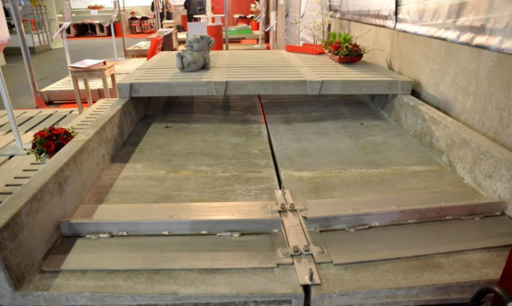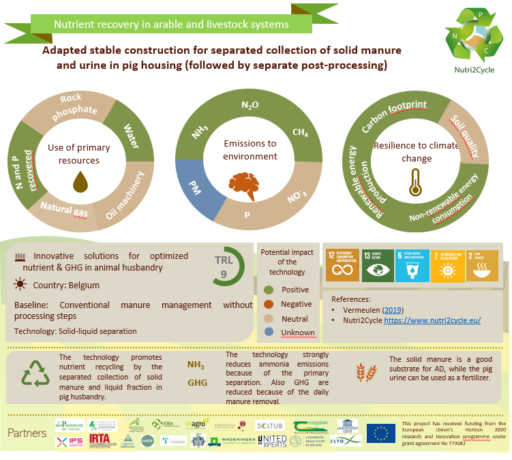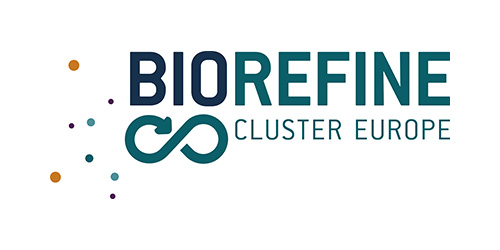2. Adapted stable construction for separated collection of solid manure and urine in pig housing (followed by separate post-processing)
RL1: Innovative solutions for optimized nutrient & GHG in animal husbandry
Responsible partners: Inagro & Ghent University,
Country: Ghent, Rumbeke-Beitem, BELGIUM

TRL and scale of set up:
This demo is at operational scale TRL 9 since there are already several adapted stable constructions built mainly in the province of West Flanders with a primary separation of pig manure. This demonstration trial facilitates the interaction with farmers on these adapted stable constructions, to follow up on how this works in practice, what the advantages and more importantly, what the bottlenecks are. Furthermore, the pig urine is being tested in a field trial to show its potential as mineral fertilizer.
Research line and priority:
This demo solution is linked to Nutri2Cycle research line 1 (RL-1: Innovative solutions for optimized nutrient & GHG in animal husbandry) and is one of the shortlist priority solutions i.e. sub-research line 15 (Organic matter recovery from manure and associated valorisation strategies).
Description of the demo:
Intensive pig husbandry is characterized by a lot of manure production, generating large surpluses of on-farm nitrogen and phosphorus. In order to prevent harmful emissions to the environment, part of this manure needs to be processed. Furthermore, ammonia and greenhouse gases are emitted from the stables. Therefore, since 2003 new pig housing systems in Flanders should be low in ammonia emission. An adapted stable construction – where there is manure separation at the source – can help to prevent emissions coming from the stable because urine is less in contact with urease, an enzyme that can be found in solid manure. An additional advantage of these types of adapted stable systems is that the resulting products (solid manure and pig urine) have lower disposal costs and can be better valorised than the pig slurry. The solid manure contains most of the P and has a good biogas potential, while the pig urine contains most of the N and K and is therefore, a good NK fertilizer without being P limited. Since Flemish soils are P-rich, the P has become the limiting factor in manure application, thereby also limiting maximum N application from animal manure. Therefore, the objective of this demonstration is to prove the benefits of adapted stable constructions in pig husbandry, leading to fewer emissions in the stable and valuable end-products. By an adapted stable construction, there is a primary separation of manure and urine in pig housing. This is because underneath the slatted floor of a stable, a shallow cellar is constructed which enables the separation of urine and solid manure. The cellar consists of two inclining parts within its middle an opening of 18 to 22 mm. Using a scraper, the solid manure is removed from the manure gutter daily. This primary separation of manure in the cellar is the basis of lower ammonia emissions. The use of solid manure as input material for farm-scale anaerobic digestion is described in the demo Farm-scale anaerobic digestion of agro-residues/pig manure to increase local nutrient cycling & improve nutrient use efficiency, and the use of pig urine as fertilizer is described in the demo field trial on maize (2019), spinach (2020) and potatoes (2021) with recycling-derived fertilizers: ammonium nitrate, ammonium sulphate, (liquid fraction of) digestate, pig urine and pig slurry.
How it addresses the Nutri2Cycle goals:
This solution creates valuable end products which are useful for energy recovery and nutrient recycling. The solid fraction of the pig manure can be used as feedstock in anaerobic digestion (see farm-scale anaerobic digestion demo), while the liquid fraction (pig urine) is a valuable N fertilizer without being P limited. This demonstration is a three-year field trial, in which the fertilizing value of pig urine is tested in practice. The most important function of any fertilizer is supplying the crop with sufficient nutrients. Nitrogen is the most important nutrient for crops and its availability is closely linked with crop yield. A mismatch between N supply and crop demand on the other hand, also leads to nitrogen losses to the environment. Therefore, the focus of this field trial lies on the short-term N-supply to the crop by the fertilizer. Pig urine is evaluated by measuring the N-fertilizer value, the effects on the crop yield and soil fertility, the soil life and nutrient losses to the environment.
Infographic



 This project has received funding from the European Union’s Horizon 2020
This project has received funding from the European Union’s Horizon 2020